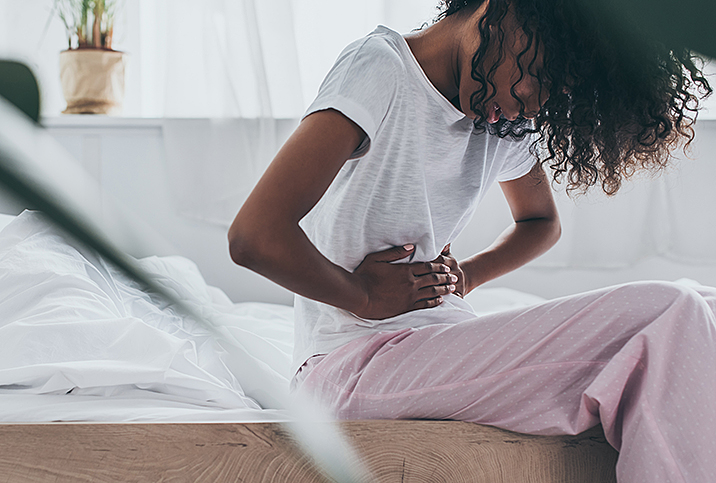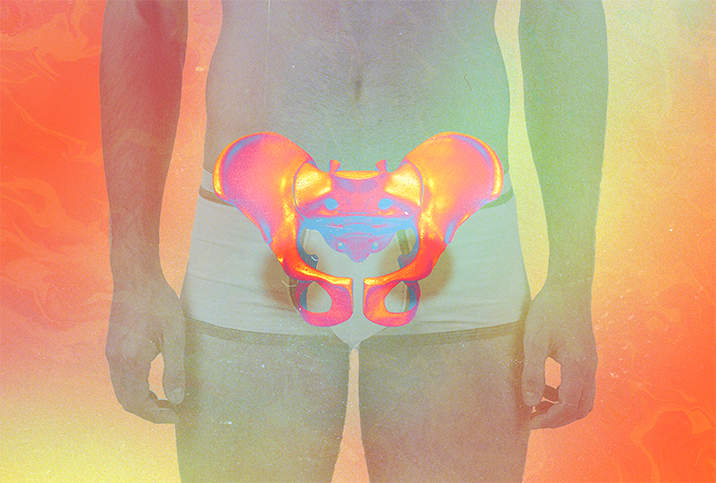Dyspareunia: A Guide to What Causes Pain During Intercourse

If you experience pain during sex, you're far from alone. Dyspareunia, or painful intercourse, affects about 3 in 4 women. Although this condition is most often associated with women, studies have shown about 1 percent to 5 percent of men suffer from pain from intercourse, too.
Despite overwhelming statistics, dyspareunia often goes neglected and is underexplored in clinical and research contexts.
Types of dyspareunia
Dyspareunia can be divided into two types: superficial and deep.
Superficial dyspareunia, known as entry dyspareunia, refers to pain felt at the vaginal or rectal opening during initial penetration.
Deep dyspareunia, known as collision dyspareunia, refers to pain felt at deeper points in the vagina and/or rectum during sexual stimulation or penetration.
Some people experience both types of dyspareunia.
Symptoms and pain can show up in several forms, such as:
- Constant pain that begins at the start of sexual intercourse
- Pain after a period of pain-free sex
- Pain during all sexual activity, including arousal, penetration and orgasm
- Pain that occurs when there is a change in the physical, emotional or hormonal state during sex
The perineum, the area between the genitals and anus, is a common site of pain during sex, according to the American College of Obstetricians and Gynecologists (ACOG). Other areas of pain include the lower back, pelvic region, uterus and bladder.
What causes pain during rectal or vaginal intercourse?
Pain with sex can happen for a variety of reasons, many of which overlap:
Endometriosis
Endometriosis affects an estimated 1 in 10 women in the United States. Endometriosis is a chronic, inflammatory condition that causes abnormal, endometrial-like tissue to grow outside of the uterus. This tissue can grow anywhere, including the ovaries, fallopian tubes and the lining of the pelvis.
Pain during sex is the third predominant symptom of endometriosis. This is because penetration (and other movements) can pull or stretch this abnormal tissue, resulting in immense pain, especially if it has grown behind the vagina and the front of the rectum.
"Dyspareunia can occur due to medical conditions such as endometriosis, which has known chronic overlapping pain conditions, including vulvodynia, interstitial cystitis and IBS [irritable bowel syndrome]," said Heather Jeffcoat, D.P.T., owner of Femina Physical Therapy, which has three locations in Southern California.
Jeffcoat said the best option for many patients dealing with endometriosis and dyspareunia is excision surgery.
Adenomyosis
Adenomyosis is similar to endometriosis. However, adenomyosis occurs when endometrial-like tissue invades the muscular wall of the uterus. This tissue growth causes heavy, prolonged periods, chronic pelvic pain, and pain during or after sex.
"Though there isn't a causal relationship between the two when you talk to women who are diagnosed with adenomyosis, it's not uncommon to hear that they have struggled with endometriosis as well," said Christine Peter, a registered nurse in Washington, D.C., who is certified in inpatient obstetric care.
Uterine fibroids
Uterine fibroids are noncancerous growths that appear inside and on the uterus. Fibroids are fairly common, with about 20 percent to 70 percent of women developing fibroids during their reproductive years.
Fibroids can cause a number of severe symptoms, including abnormally heavy and prolonged periods, lower back pain and pelvic pain, as well as pain during intercourse, though some individuals may experience no symptoms.
Retroverted uterus
A retroverted uterus—known as a tilted uterus—is one tilted backward at the cervix toward the spine. About 25 percent of women have a tilted uterus.
The other 75 percent of women have an anteverted uterus or a uterus that tips forward at the cervix, toward the stomach. A retroverted uterus doesn't typically cause problems. However, individuals with an associated condition, such as endometriosis or uterine fibroids, may experience pain with sex (particularly if they're in a sex position where they're on top) and period pain.
Interstitial cystitis-painful bladder syndrome (IC-PBS)
IC-PBS is defined as bladder-related pelvic pain, pressure or discomfort, usually accompanied by a constant urge to urinate or frequent urination.
In other words, this condition causes symptoms similar to a urinary tract infection (UTI), except with no infection. Unmanaged IC-PBS can affect every aspect of your life, including your intimate relationships.
According to a survey conducted by the Interstitial Cystitis Association, 90 percent of respondents reported their IC-PBS kept them from being intimately involved with their partner. Additionally, men with IC-PBS can experience genital and perineal pain similar to that of vulvodynia, pain with intercourse, and pain during and after ejaculation.
Vaginismus
Vaginismus occurs when a person's pelvic floor muscles involuntarily tense up when faced with penetration of the vagina. This muscle movement can make intercourse very painful or even impossible.
According to the National Institutes of Health, vaginismus is thought to be one of the most common female psychosexual dysfunctions. Though the prevalence rate is unknown, rates at sexual dysfunction clinics range from 5 percent to 17 percent.
"A medical dilator program instructed by a pelvic floor physical therapist is often the primary treatment for vaginismus," Jeffcoat said. "Occasionally, patients may require Botox to the pelvic floor muscles, vaginal suppositories that help with muscle spasm and/or concurrent psychotherapy to address relationship or intimacy issues that may be underlying their condition."
Phimosis and clitoral phimosis
Phimosis is a condition in which the foreskin of an uncircumcised penis is too tight to be pulled back over the head of the penis, causing the tip of the penis to become sore and uncomfortable during intercourse. This condition affects most newborn males: Only an estimated 1 percent of people still have phimosis by 16 years old, according to Cleveland Clinic.
Though phimosis can be treated with circumcision—the surgical removal of the skin covering the tip of the penis—most men who have this condition prefer to try nonsurgical treatments, which involve topical steroids.
Clitoral phimosis is an anatomical disorder involving the hood of skin around a woman's clitoris being fully or partially disabled, such as being too tight. A 2002 study published in the Journal of Sex & Marital Therapy suggested 22 percent of women suffer from clitoral phimosis.
Typically, treatment for clitoral phimosis involves topical corticosteroids in tandem with oral antibiotics, but more severe cases could require surgery.
Curved penis
Penises vary in shape, length and girth, and some men have a curved penis, which can pose functional challenges to having intercourse.
Penile curvature can be a congenital condition, meaning it's present at birth. In some cases, however, a curve can develop later in life as the result of a medical condition, such as Peyronie's disease, or an injury.
Postorgasmic illness syndrome (POIS)
POIS, or postorgasmic illness syndrome, is a rare and under-researched condition characterized by a sudden onset of flu-like symptoms, including nausea, dizziness, weakness and fatigue, shortly after having an orgasm. These symptoms can endure for an hour to several days.
POIS has been reported to occur in both men and women.
Chronic bacterial prostatitis
Chronic bacterial prostatitis is a long-term bacterial infection in the prostate gland that can cause symptoms including urinary issues and pain in the genitals, including the rectum. These symptoms often worsen over time and, in some cases, lead to erectile dysfunction (ED).
For most people, chronic bacterial prostatitis occurs when bacteria enter the soft tissue of the prostate, resulting in infection. Symptoms of bacterial prostatitis include pelvic pain, urgency and painful intercourse, among other symptoms.
It's impossible to transfer bacterial prostatitis to a partner, but it can cause sexual problems for men who suffer from the condition. Antibiotics are usually the first course of treatment for chronic bacterial prostatitis.
Other causes of pain during rectal or vaginal intercourse
Other possibilities for pain during intercourse include:
- Cancer and cancer treatment
- Chronic pelvic pain syndrome (CPPS)
- Injury or trauma
- Irritable bowel syndrome (IBS)
- Medications
- Nonbacterial chronic prostatitis
- Ovarian cysts
- Pelvic inflammatory disease (PID)
- Polycystic ovary syndrome (PCOS)
- Psychological issues, such as stress, anxiety, depression and low self-esteem
- Scar tissue or pelvic adhesions
- Sexually transmitted infections (STIs)
- Skin conditions
- Vaginal dryness
- Vestibulodynia
- Vulvodynia
- Other infections, such as urinary tract or yeast infections
How is dyspareunia diagnosed?
If you're experiencing pain with sex, reach out to your OB-GYN or primary care doctor. They can do a physical exam and may order tests to rule out the causes of your pain. These may include tests, an ultrasound of your pelvic area and/or a pelvic exam.
During your appointment, your doctor may ask about your medical history and lifestyle habits, including questions about your nutrition, activity levels and sexual practices. The doctor may also ask you to go into detail about your symptoms to get a better idea of what might be causing them.
"Any cause of pain needs to be explained so that it can be addressed," said Carol Queen, Ph.D., resident sexologist at Good Vibrations, based in San Francisco. "This means a person must know that sex doesn't have to hurt. They must have access to healthcare, be able to bring it up, and have a doctor who's knowledgeable and can talk about these things to a possibly ashamed and frightened patient.
"Try to find a doctor who has specific training about sexual functioning. Not all have much of that," Queen added.
Treatment options
The treatment that's best for you will vary depending on the cause of your dyspareunia.
Some cases may require the use of medications, with the first line of defense for dyspareunia typically being topical estrogen. Another example is ospemifene (brand name: Osphena), a drug approved by the Food and Drug Administration and designed to treat vaginal dryness and pain associated with intercourse in women who've gone through menopause.
Other treatment options for painful sex include therapies such as desensitization therapy, counseling and sex therapy. A pelvic floor physical therapist may also be able to help you normalize the activity of your pelvic floor muscles to reduce any pain you may be experiencing during intercourse.
Tips for coping and improving your sex life
Intercourse isn't the only way to be intimate with your partner. Nonpenetrative activities such as kissing, oral sex, massage, touching and "dry humping" are all things you can do to ease yourself back into your comfort zone.
You can also try switching positions—sometimes adding a pillow in the mix can help—or taking a warm bath together to relax your muscles and ease any discomfort you might be feeling. Making an effort to stay relaxed can help boost your confidence as well. You could also try incorporating deep-breathing techniques or meditation to help you clear your mind and relax your body before having sex.
And remember, there's no shame in taking some time before you attempt intercourse again.


















